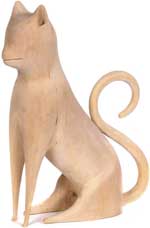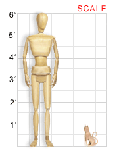VAM galleries including this work:
Kentucky Folk Art Center | Animal Farm || VAM Home
Linvel Barker (Kentucky, 1929-2004)
SITTING CAT, 1989
Wood; 11" X 6-1/2" X 3-1/2"
1989.6.4
Kentucky Folk Art Center
This unpainted wood carving is a good example of the elegant simplicity of Linvel Barker’s work. The proportions of the cat are somewhat realistic, except for delicate legs and feet (a characteristic of Barker’s carved animals).
About the Artist
Linvel Barker left Kentucky in the early 1950s for northern Indiana, where he worked for more than 30 years as a maintenance technician at a steel mill. In the mid-’80s, he retired and returned to his wife’s home community of Isonville. A preacher, he tended to the small congregation of a church he took on as pastor, but he felt very uneasy without the familiar routine and sense of purpose that he had been used to during his working life. At the coaxing of his neighbor, folk artist Minnie Adkins, he tried carving wood and discovered that he enjoyed it. The first few pieces he produced were soon bought by collectors, and wood carving quickly became a daily activity.
Barker’s carvings are easily identified by their streamlined shape; their delicate, thin legs; and the fine, smooth finish treatment he gave to the blond, unpainted basswood from which he made them. His wife, Lillian, helped him in the finish stage of his work and also began to paint on her own.
After Lillian’s death in 1997, Barker stopped carving, and his own health deteriorated. He was confined to a nursing home in 2000 and lived there until his death in 2004. Although he worked as an artist for a relatively brief time, Barker’s unique sculptures are sought after and valued by collectors of contemporary folk art.
Classroom Ideas
Discussion: How does this artist use the elements of art? What types of lines do you see? Do you think this piece conveys the physical characteristics of a cat? Does it convey the spirit or personality of a cat? Why might the artist choose to depict a mouth on the cat but no other details? What kind of impact does the unfinished wood have on the viewer? Would the impression be different if the artist had chosen to paint the work? What must a sculptor consider when choosing a type of wood to carve? How do different types of wood affect the final appearance and character of an artwork?
Compare this work to images of other works by Barker. Why do you think the artist chooses to give even large, bulky animals delicate, thin legs and feet? Compare this cat to cat figures found in Egyptian tombs. What characteristics of cats seem to impress artists working thousands of years and thousands of miles apart?
Activity: Choose an animal. Draw it, using basic shapes and few details. Sculpt it in clay in a style similar to Barker’s. Look at different types of wood and choose a wood that would be appropriate for a carving of your animal.
Links
See a carving of a buffalo by Barker at the Kentucky Museum of Art and Craft web site.
[www.kentuckyarts.org/exhibition.cfm?stepaction=category.cfm&gid=232&gscid=53]


